I attended a most fabulous kimchi pickling workshop earlier this week hosted by Cham Korean Bistro, my favorite restaurant in Pasadena. The event was held at the restaurant’s R&D kitchen in the little-visited city of Vernon and was attended by all sorts of food-adoring media types including my pals B-Side, H.C., Javier, Valentina, Esther, and Eddie. We were all eager to learn the ins and outs of fermentation and to expand our knowledge of Korea’s beloved dish.
Led by Chef EJ Jeong, formerly of BOA and A.O.C., the two hour-long class was fun, educational, and most importantly, tongue-searingly delicious. While teaching us how to make traditional Napa cabbage kimchi (tong baechu kimchi), Chef Jeong weaved in hilarious stories about her family and culture. My favorite anecdote recounted a popular Korean saying that “a man can live without a wife, but not without kimchi.” Now, that’s some serious affection!
Before the class officially began, we were treated to a selection of small bites including tofu pockets, kale chips, and seared tuna on a stick. I’ve enjoyed the spicy tuna and seaweed pockets countless times at the restaurant, but the kimchi variety was new to me. The best part of the kimchi pocket was that it was topped with candied anchovies! I’m crossing my fingers that it becomes a menu mainstay because the world needs more candied little fishes.
After we filled our bellies halfway, it was time for the learning to commence…
The ingredients for the tong baechu kimchi were laid out neatly for us. The recipe is a three step process. First, the cabbage needs to soaked and salted. Second, the marinade has to be prepared. Lastly, the cabbage is combined with the marinade and left to ferment for three weeks.
For Napa cabbage
- 2 heads Napa cabbage
- 2 cups sea salt
- 8 cups water
For kimchi marinade
- 1 cup sweet rice powder
- 5 cups water
- 1 cup coarse Taeyangcho red chili pepper powder
- 5 ounces garlic
- 10 ounces Asian pear, peeled and quartered
- 9 ounces onions, peeled and quartered
- 1 ounce ginger, peeled
- 4 ounces Fresno chilies
- 2 pounds radish, julienned
- 4 ounces minari
- 4 ounces red mustard greens
- 4 ounces Korean chives
- 4 ounces green onions
- 1/4 cup Korean anchovy fish sauce
- 3/4 cup Korean salted shrimp sauce
- 4 ounces fresh shrimp, chopped
- 4 ounces Korean salted shrimp
Prepare Napa cabbage—Trim the cabbage by removing any brown leaves on the outer layers. Slice the center of the cabbage’s stem 2 inches deep. Using your thumbs and hands, pull the cabbage into two sections through the slit. Repeat for the remaining cabbage.
Soak the cabbage sections in salted water (8 cups water to 1 cup sea salt) for 20 minutes. After 20 minutes, remove the cabbage from the salt water and sprinkle the remaining 1 cup of salt between each of the cabbage leaves.
Return the cabbage to the salted water with the cut side facing up. Rotate the cabbage every two hours, bringing the cabbage on the bottom of the container to the top and vice versa.
After 5-6 hours, the texture of the cabbage will be properly rubbery. Wash the cabbage thoroughly and gently. Drain the cabbage in a colander, squeezing as much water from the leaves as possible. Set aside.
Prepare kimchi marinade—Combine the water with the sweet rice powder and whisk until smooth. Heat the water and rice powder mixture on the stove on medium-high heat, stirring occasionally to prevent it from sticking to the bottom of the pan. When bubbles start to form, reduce the heat and continue to stir. Once the mixture thickens and becomes translucent (approximately 10 minutes), take it off the heat. Cool the mixture completely.
Once the rice powder mixture has cooled completely, transfer it to a large bowl. Add the red chili pepper powder to the rice powder mixture and combine well.
Place the onions, pear, garlic, ginger, and Fresno chilies in a food processor and pulse until finely minced. Set aside.
Add the pureed chili mixture, along with the radish, minari, red mustard greens, chives, and green onions to the rice powder mixture. Combine the mixture thoroughly, making sure that the greens are incorporated completely.
Lastly, add in the anchovy fish sauce, salted shrimp sauce, and fresh and salted shrimp. Once again, combine the mixture very well. If mixing with your hands, be sure to wear rubber gloves to avoid chili burn.
Prepare the kimchi—Take the cabbage and stuff the marinade mixture between the leaves, working from outside in, starting with the largest leaf to the smallest. Do not overstuff, but make sure the marinade mixture adequately fills the leaves.
When entire cabbage is stuffed, take one of the larger leaves and wrap it tightly around the rest of the cabbage. Divide the cabbage among jars, pressing down firmly to remove any air bubbles. Only fill the jar 80 percent full because the kimchi will expand as it ferments. Keep the jar tightly sealed and refrigerated for at least 20 days. [For Printable Recipe Click Here]
As a reward for all of our hard work, we were treated to beautiful plates of bo saam that included a fresh oyster, tiny salted shrimps, fermented chili paste, slices of pork shoulder, radish kimchi, wilted Napa cabbage, and sesame leaves. The Chef also made a special batch of white kimchi and persimmon kimchi to complement the bo saam.
Soon after, we departed into the night with our breaths reeking of garlic and generous jars of freshly made kimchi destined for our refrigerators.

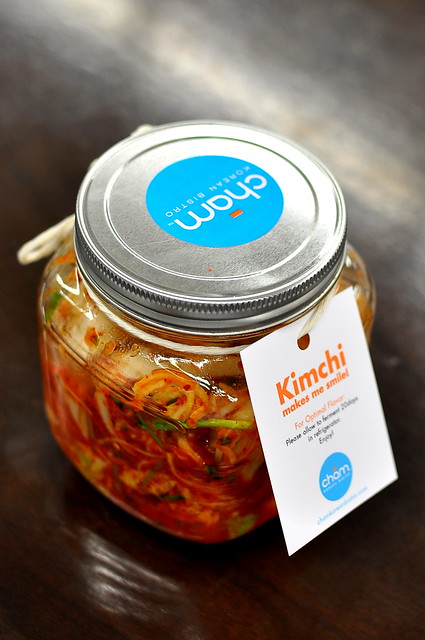


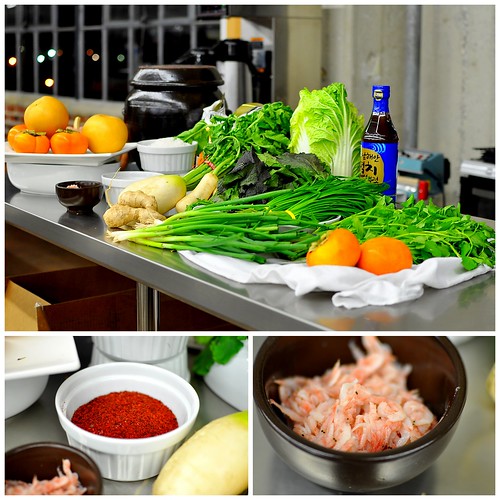
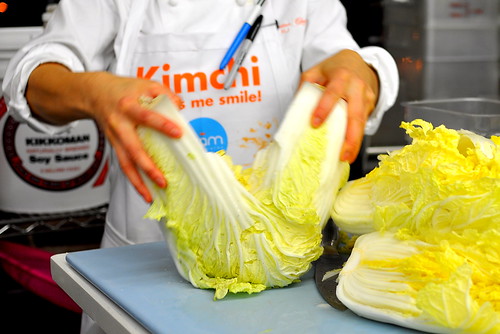
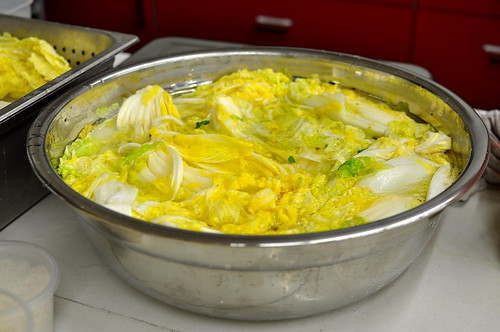
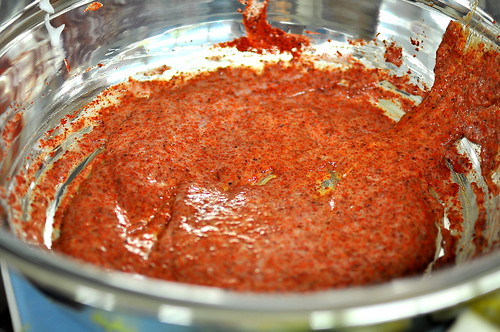
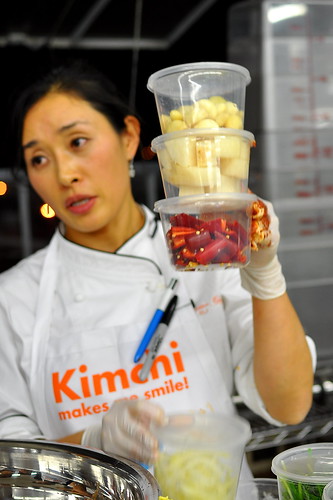
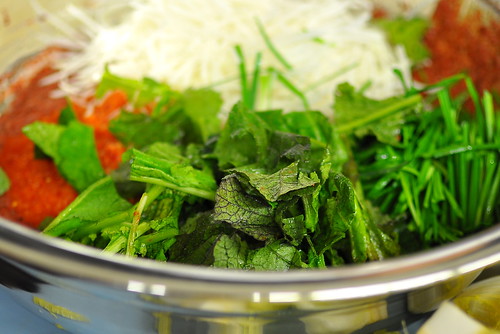
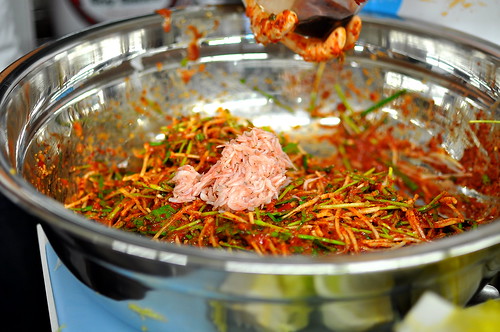
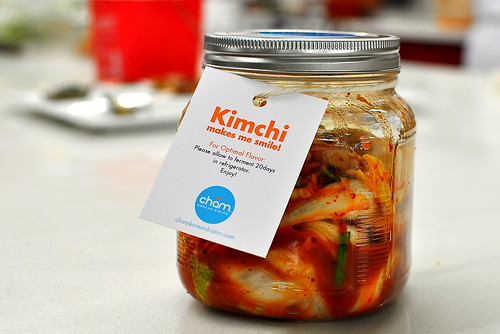
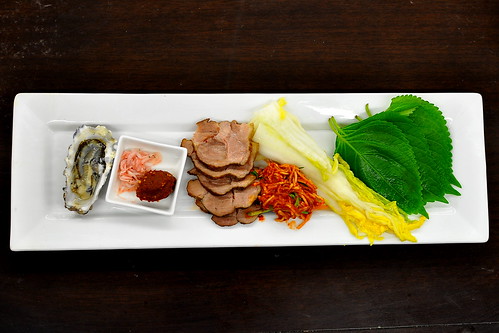
What an incredible experience this was for you. Thanks for sharing it with us – as always. I’m impressed with how clean she’s made the process look, because in the many TV shows I’ve seen where Kimchi is made, it looks like really messy business.
Awesome photos, as usual. You and that camera . . . I swear.
Wow, this is awesome. Persimmon kimchi?!?!
Maybe I’ll try making kimchi…perhaps over the Thanksgiving holiday when my mom is in town. I can steal her recipe.
I want Chef’s apron…
Nice pics and instructions. I’ve always wanted to make kimchi, but just feel it’d be best to have an experienced person walk me through the steps. You’re very lucky to have had the experience.
Awesome! Thanks for this. I’ve always wanted to make my own kim chi but have been too intimidated. I keep asking my Korean friends by they’re all clueless too. Great post!
Looks so interesting! Beautiful pictures as always. I really want to try this but that ingredient list for the marinade is kind of daunting…
Wow, this looks like a fun class and I absolutely love kimchi. 🙂
I never would have though kimchi had asian pear in it! wowzers
Cant wait to try this recipe!!
Nicely reported! This brings all the fun & flavors back!! Thanks.
wow, awesome. i love kimchi…. this looks like a really informative/fun class. nice.
that looks like so much fun! only, you know, the smell of the actual pickling process in a small 1 bedroom apartment… might be a no bueno.
It looks so clean and delicious~ nice work, EJ!!
I will share with my friends!!
I still really want to come out to dena for Cham. Is that kimchi pocket with candied anchovy on the menu now?
Do you think you’ll attempt making kimchi at home now? Maybe you can whip up a batch to sell at EMB… 😉
Great post – definitely going to try this at home now. Love the fat you have access to different types of kimchi too – despite having a decent Korean population we only seem to get the standard variety in Sydney. The persimmon kimchi sounds interesting!
What lovely packaging, that is a damn fine looking bottle of kimchee. I grew up on tofu footballs (inari) but never had them with kimchee and topped with iriko. Sounds fantastic!
Hey Kathy, great pics and I bet it was an awesome class. Is the salted shrimp sauce the same as Vietnamese mam tom?
donmoocao – Check this out: http://www.koreanhomecooking.com/2008/02/salted-shrimp-sauce-sae-wu-jut.html Looks like a completely different beast than mam tom.
Hrm.. Ok. What’s the difference between the 3/4 cup Korean salted shrimp sauce and the 4 ounces Korean salted shrimp? Is the the juice and the actual shrimp?
Hi I was looking at kimchi recipes today and I really liked your photos. All the ingredients are easily identified and your layout and text pull me in. So… I was shocked to see those beautiful photos badly sized on a less inspired website.
http://alonelifeinspired.blogspot.com/2011/02/how-2-make-kimchi.html
Thanks for bringing this to my attention, VicB. I’ve left a comment on the offending site. Hopefully they’ll remove my copyrighted content from their site ASAP.
this is very helpful.
wish i could cook one and eventually taste one.
i’ve only seen this dish in korean movies that we watched and they seem to be so delicious,. ^^
Just had kimchi for the first time this weekend, now I’m kinda obsessed. Lots amazing!
🙂 i love kimchi
Thanks for the explanation. You show us how to make kimchi step by step so that it ease us to follow and make it at home. I am vegetable lover and this is great recipe.
I’m planning to make Kimchi this Thursday for the party on Saturday. Since it’s by my friend’s special request, I want to excel!
The colour look amazing and I’m sure it must taste exquisite.
Your post will help my Kimchi making mission.
How long can the product be stored. I am planning to produce it an export abroad.
Tochi – Refrigerated and sealed air-tight, the kimchi can last practically forever. However, once the jar is open, the kimchi is only good from 3 months to 6 months since there are no preservatives in this recipe.
I wish I could have an update news of your recipes. Right now, I am craving to know the ingredients for Persimon Kimchi. I love this kind of fruit. How about teaching us in making kimchi?
More power to your column.
im a filipina but i do love kimchi… my korean friend named meg hong taught me how to make kimchi before, my problem is i dont know the names of the liquid ingredients needed in making a kimchi….help me pls…. i also love korean sesame leaves
When fermenting in the fridge, do I need to “burp” the jar at all? Thanks! Gorgeous pics!
Renae – Nope. Just let it ferment for a month and you’ll be good to go!
How much does this recipie yeild?
Lucy – This recipe makes two heads of Napa cabbage worth of kimchi.
Thanks! So would that be around 2 quart jars?
Lucy – The kimchi expands as it ferments, so I’d go with 3 jars just to make sure that it doesn’t explode. It’s perfectly fine if the jars aren’t filled to the brim.
Thanks so much!
Hi, I’m trying to find out what salted shrimp sauce is. I can find brined shrimp but no recipe (anywhere on the internet!) for salted shrimp sauce. Please help I’m dying to make my own kimchi!!! 🙂
you can buy it in jars at any Korean grocery store, it’s thousands of baby shrimp packed in a brine and incredibly salty (you only use a tiny bit)
Thank you for posting this. I made some using your recipe a little over 3 weeks ago, and I just tasted it for the first time. It’s very tasty, and very hot indeed! Lovely.
I did have some trouble finding some of the ingredients, such as Minari, Asian pear (I substituted a normal pear) and Korean parsley, but it’s still turned out great I think.
It is a fairly labourious process, but well worth it!
wicked imp !!!kimchi bangs me inside !! 😉 now i make my own kimchi 😉
i love kimchi
I really love kimchi. Kimchi for the others is only a side dish, but for me I always make kimchi as viand and always included to my course. Hahaha!
please tell me is there household ingredients that I could use to make this, do not have the fish seafood or rice powder or all the different fruits and yet do have fruit peppers dried and fresh, and tuna in can. lots of similar ingredients, but none of the ones like minari. I do have ginger too. a cheap household recipe for fermented cabbage, not just a sauerkraut, but similar to the kimchi. I would love the chili and other peppers and some fruit and ginger even garlic. just frustrated, cause on bucket list would like to make some. thanks.
Urgent! I’m making your kimchi right now, a half-recipe. Is the 8 cups of water to 1 cup salt a mistake? The photo shows a huge bowl, presumably with 2 heads of nappa easily floating in the brine. My 8 cups water barely wets the bottom of one head of split nappa.
I wonder if this should be 8 QUARTS of water, not CUPS? Thanks for sharing your experience.
Cassandra – There should definitely be enough salty water to submerge the cabbage completely. Best of luck!
Thank you for sharing your experience and the gorgeous pics. A couple of questions if you don’t mind. Is the cabbage still attached at the base? Or have they come apart with the soaking? I’m trying to picture wrapping the largest cabbage leaf around the stuffed cabbage as well as how they are put into the jars. Thanks.
I love that mouth-watering kimchi, and glad to find an asian store sell some which is not always the case. Now, I can make my own kimchi at home. Some nutritionists gave me an idea that it is rich in probiotics. Good stuffs! Thanks for the recipe and procedures of making it. Nice presentation. 🙂
Oh I am so jealous you were able to attend this. When I was in culinary school we had an older Korean lady in our class. She showed some of us how to make it quickly, I wish we had more time to learn from her.
This was a lovely post, I’ll be sure to try it eventually.
A beef burger topped only with Kimchi is insane, no other condiment or ingredient is required, I am hooked on my Kimchi Burgers!
I would like to make this Kimchi but I don’t know the difference between the Salted Shrimp and the Salted Shrimp Sauce. When I went to the Korean Grocery, they told me they are the same thing.
Cucumber Kimchi is the best!
Make the red paste in this recipe.
Soak cucumbers in a salt brine/bath for a period of time, strain and mix with red paste.
Awesomeness ensues.
Try the cucumber kimchee on a burger.